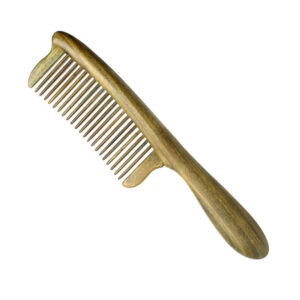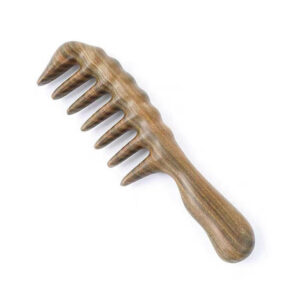Last updated on March 19th, 2025 at 06:26 am


Sandalwood is known as the “magic wood of the hair” and it has many beneficial properties for hair. Firstly, sandalwood has antibacterial and anti-inflammatory properties that help to remove bacteria from the scalp and reduce inflammation. Secondly, sandalwood oil can nourish hair and promote hair growth. It not only increases blood circulation to the scalp but also provides essential nutrients that bring nourishment and strength to the hair roots.
Benefits of sandalwood oil
1. Solves scalp problems
1.1. Removes dandruff
Sandalwood oil has anti-fungal properties that help reduce dandruff caused by fungus on the scalp. Mixing a few drops of sandalwood oil with coconut oil and gently massaging it into the scalp can help remove dandruff and keep the scalp clean.
1.2. 2. Relieves inflammation
The active ingredients in sandalwood oil have anti-inflammatory properties that can relieve scalp inflammation and itchiness. By diluting sandalwood oil and applying it directly to the inflamed area, it can help reduce discomfort and soothe the scalp.
1.3. 3. Cleansing the scalp
Sandalwood oil can be used as a natural shampoo that can help remove oils and impurities from the scalp and hair strands. Use sandalwood oil in shampoo to deep cleanse the scalp while moisturizing the hair.
2. Promotes hair growth
2.1. Increases blood circulation
Sandalwood oil has a warm nature that stimulates blood circulation on the scalp. By increasing blood circulation, the supply of nutrients to the hair will increase and promote hair growth. Mixing sandalwood oil with a carrier oil such as coconut oil or olive oil and then massaging the scalp with your fingertips can stimulate blood circulation in the scalp.
2.2. Nourishes hair roots
Sandalwood oil is rich in a variety of hair-healthy nutrients such as vitamin E, vitamin C, and antioxidants. These ingredients nourish and strengthen the hair roots, thus promoting hair growth. During a scalp massage, sandalwood oil penetrates the scalp and provides the hair roots with the necessary nutrients.
2.3. Enhances hair texture
Sandalwood oil can repair and protect the hair strands. It repairs damaged hair strands and reduces split ends and breakage. Sandalwood oil also forms a protective film that prevents the hair from damage caused by environmental pollution and hot styling tools. As a result, hair will be softer, smoother, and shinier.
How to use sandalwood oil?
1. Scalp massage
Scalp massage with sandalwood oil is a great way to promote hair growth and improve scalp health. Here is how to use sandalwood oil for scalp massage:
- Prepare the ingredients: Mix sandalwood oil in proportion to a suitable carrier oil such as olive oil or coconut oil. It is usually recommended to mix sandalwood oil with a carrier oil in a ratio of 1:3.
- Massage the scalp: Pour the mixture of sandalwood oil and carrier oil into the palm of your hand and gently massage the scalp with your fingertips. You can massage in small circles, starting from the forehead and gradually moving to the top of the head and the back of the head. Massage the scalp with moderate force and in a comfortable manner.
- Massage time: The duration of scalp massage varies from person to person and is generally recommended to be 5-10 minutes. It can be adjusted according to personal preference and time.
- Gently combing: After the massage is completed, gently comb the hair with a wide-toothed comb. This helps distribute the sandalwood oil evenly through the hair and promotes a balanced distribution of scalp oils.
By performing regular scalp massage with sandalwood oil, you can stimulate blood circulation in the scalp, provide nutrients to the hair roots, and increase hair quality. In addition, scalp massage relaxes the mind and body, promotes sleep, and relieves stress.
2. Hair care
Sandalwood oil can be used with shampoo or conditioner to enhance hair care. Here are the ways to use sandalwood oil for hair care:
- Choose an appropriate shampoo or conditioner: Choose a shampoo or conditioner that is silicone-free, alcohol-free, gentle, and natural. Such products are more suitable for mixing with sandalwood oil for better results.
- Add Sandalwood Oil: Each time you use your shampoo or conditioner, pour an appropriate amount of shampoo or conditioner into the palm of your hand or a bowl and add a few drops of sandalwood oil. Generally, 5-10 drops of sandalwood oil mixed with the right amount of shampoo or conditioner is enough.
- Mix well: Mix the sandalwood oil and shampoo or conditioner well to ensure that the sandalwood oil is well dispersed in the product.
- Shampoo or Condition: Apply the mixed shampoo or conditioner according to your normal shampoo or conditioning routine. Apply gently to wet hair, massaging the scalp and ends so that the sandalwood oil covers the hair evenly.
- Rinse well: Rinse hair thoroughly with warm water to ensure that the sandalwood oil and shampoo or conditioner are completely clean.
By adding sandalwood oil to your shampoo or conditioner, you can enjoy its hair care benefits more conveniently. Sandalwood oil moisturizes and strengthens the hair, making it softer, smoother, and scented with the fragrance of sandalwood.
3. Direct contact
Apart from mixing it with shampoo or conditioner, you can also apply sandalwood oil directly to your hair with your fingertips for a more concentrated hair care effect. Here’s how to use sandalwood oil for direct hair contact:
- Prepare sandalwood oil: Take an appropriate amount of sandalwood oil in a container or the palm of your hand.
- Apply to hair: Apply sandalwood oil gently with fingertips to wet or dry hair. You can focus on the middle to ends of the hair as these areas are usually more prone to damage.
- Massage gently: Use your fingertips to gently massage the hair and ends to allow the sandalwood oil to better penetrate and nourish the hair.
- Avoid over-application: Be careful to use the right amount of sandalwood oil and avoid over-applying it as it may make your hair greasy.
By applying sandalwood oil directly to your hair, you can concentrate on moisturizing your hair and ends, enhancing the health and shine of your hair. Additionally, sandalwood oil provides a long-lasting fragrance to your hair, giving you a natural and captivating scent.
Precautions for using sandalwood oil
1. Use the right amount
It is very important to use the right amount of sandalwood oil as overuse of sandalwood oil may hurt your scalp and hair. The following are suggestions for using the right amount of sandalwood oil:
- In most cases, 5-10 drops of sandalwood oil per application is sufficient. Adjust the amount you use in moderation based on the length and consistency of your hair.
- If you are using sandalwood oil for the first time, it is recommended to start with a smaller amount and gradually increase it as needed.
- It is important to mix sandalwood oil well with a carrier oil such as coconut oil or olive oil. This ensures that the sandalwood oil is fully diluted and reduces scalp irritation.
By taking care to use the right amount of sandalwood oil, optimal hair care can be achieved without any negative effects on the hair and scalp.
2. Dilution
Despite the many benefits of sandalwood oil for hair, pure sandalwood oil can be a little too strong or irritating for some people. Especially for those with sensitive skin, it is safer and more comfortable to use sandalwood oil in a moderately diluted form. The following are suggestions for diluting sandalwood oil:
- Use vegetable oils as carriers: Choose vegetable oils that are suitable for your skin type, such as olive oil, sweet almond oil, or coconut oil. These carrier oils can effectively dilute sandalwood oil and provide additional moisturization and nourishment.
- Oil Ratio: Mix Sandalwood Oil with a carrier oil at a ratio of 1:3 to ensure Sandalwood Oil is properly diluted.
- Test for skin reaction: Before applying Sandalwood Oil, it is best to perform a small test on the arm to ensure that no allergic or irritating reaction occurs.
- For people with sensitive skin, diluting Sandalwood Oil will reduce skin irritation and ensure a comfortable application experience. In case of any discomfort or allergic condition, stop using Sandalwood Oil immediately and consult your doctor.
By taking care to dilute and use Sandalwood Oil in moderation, we can maximize its benefits for hair and reduce potential skin problems.
3. Quality Standards
Choosing a high-quality sandalwood oil is very important as only pure sandalwood oil can deliver its hair care benefits at its best. The following are suggestions for choosing pure sandalwood oil:
- Confirm source and manufacturer: When purchasing, find out where the sandalwood oil comes from and the reputation of the manufacturer. Good quality sandalwood oil usually comes from a company or supplier with a good reputation and traceability.
- Check the ingredients: Check the product label to ensure that sandalwood oil is one of the main ingredients in the product and not diluted or adulterated.
- Purity testing: If possible, choose sandalwood oil that has been tested for purity. These tests ensure that sandalwood oil is not adulterated or contaminated and maintains its natural benefits.
- Fragrance and color: Pure sandalwood oil usually has a strong fragrance and a dark brown color. A fragrance that is too light or a color that is too bright may mean that the oil is adulterated or impure.
By choosing pure sandalwood oil, we can be sure that we are getting the highest quality product to utilize the full benefits of sandalwood oil in hair care. Once using pure Sandalwood Oil, we can expect to solve scalp problems, promote hair growth, improve hair texture, and make hair healthier and shinier.
4. Pre-use Tips
Before using sandalwood oil as a hair care product, we need to know a few things about how to use it and what to look for. This will help ensure that we use sandalwood oil correctly and get the best results. Here is what you need to know before using sandalwood oil:
- Read the product description: Read the product description and directions for the use of sandalwood oil. Different brands and products may have different recommendations and instructions for use.
- Determine the appropriate method of use: Find out which method of use suits your needs and preferences. You may choose to massage your scalp, add it to your shampoo or conditioner, or apply sandalwood oil directly to your hair.
- Determine the appropriate frequency of use: Depending on your situation and needs, determine how often you should use sandalwood oil. Generally speaking, a frequency of use of once or twice a week is common.
- Know your personal allergy history: If you have ever been allergic to certain plants or chemicals, be sure to have your skin tested before using sandalwood oil. Apply a small amount of sandalwood oil on a small area on the inside of your arm and watch for any allergic reaction.
- Precautions for Pregnant and Nursing Women: If you are pregnant or breastfeeding, consult your doctor for advice before using sandalwood oil.
Conclusion
Sandalwood oil is a natural and effective hair care product that can solve scalp problems, promote hair growth, and improve hair texture. Enjoy the benefits of sandalwood oil for our hair by knowing the proper usage and precautions.
Whether you want to moisturize your hair, improve its texture, or address scalp issues, sandalwood oil can be an indispensable and natural choice for your hair care. Are you ready?
Love Tips
Choosing a wooden comb will reduce hair loss, and sandalwood combs reduce friction with the scalp, create a massaging effect on the scalp, protect the scalp, reduce hair loss, and stimulate healthy hair follicle development!


